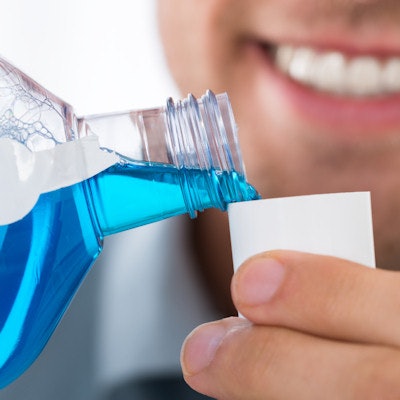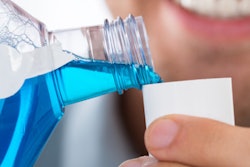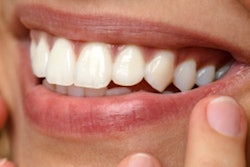
Chlorhexidine is known for reducing plaque, but how do mouthwashes with varying chlorhexidine concentration levels compare? Researchers tested three chlorhexidine solutions to see which was better at combating plaque and gingivitis, and they found some unexpected differences.
Researchers from Norway experimentally induced gingivitis in study participants and monitored them as they used a chlorhexidine mouthwash with one of three solutions (0.2%, 0.12%, or 0.06%) for 21 days. The formulations had varying effects on plaque accumulation but not on gingivitis, appearance, or significant changes in taste.
"A commercially available mouthwash containing 0.2% chlorhexidine had statistically significant better effect in preventing dental plaque than the 0.12% and 0.06% solutions," wrote the authors from the periodontology department at the University of Oslo Institute of Clinical Odontology (BMC Oral Health, August 18, 2017).
Most effective concentration
Chlorhexidine is a bisbiguanide with bacteriostatic and bactericidal effects, and it has been sold in Norway primarily as a 0.2% nonalcohol solution. More recently, a 0.12% chlorhexidine mouthwash and 0.06% solution have been approved for marketing and are being sold in that country.
The researchers conducted the current study to help practitioners select the most effective concentration for reducing plaque. They initially thought that the two higher-concentration products would be equally effective at preventing plaque buildup.
The 0.2% and 0.12% solutions are recommended only for short-term use, such as for patients unable to practice adequate dental hygiene. A few studies have compared the 0.2% and 0.12% products and found the 0.2% solution to be slightly more effective at reducing plaque.
The 0.06% solution, on the other hand, is for daily use, and the manufacturer claims that it prevents gingival problems and reduces the amount of plaque by 3.5 times compared with mechanical tooth cleaning.
The double-blind, randomized study included 60 healthy dental, dental hygienist, and medical students at least 18 years old who did not smoke or use tobacco. Participants used a 0.2%, 0.12%, or 0.06% commercially available chlorhexidine mouthwash for 21 days.
The participants underwent a professional teeth cleaning at the start of the study, so they had a baseline plaque score of 0. They were instructed to brush and floss their teeth twice a day while wearing a tooth guard in the upper right quadrant (quadrant one) to prevent that area from undergoing regular oral hygiene. They were told to rinse their mouths with tap water for 30 seconds before and after removing the tooth guard, after which they rinsed with 10 mL of the chlorhexidine solution.
The researchers asked participants about side effects on study days 7, 14, and 21. At day 21, participants underwent plaque index and gingival index scoring and a clinical examination for adverse events.
Based on the day 21 scoring, individuals who used the 0.2% chlorhexidine rinse had statistically significant (p < 0.05) lower average plaque scores than those in the other two groups for three measures:
- All surfaces combined
- Proximal surfaces only
- Mesial, buccal, and distal surfaces together
However, the researchers found no statistically significant differences among the groups in buccal and palatal surfaces combined and palatal surfaces only. The overall, plaque index scores are shown in the chart below. The lower the index score, the better.

In comparison, unpublished data from one of the study authors showed an average plaque score for all surfaces of 1.7 in participants who rinsed their mouths with water only.
The researchers found no differences among the groups in plaque index or gingival index scores in quadrant two, which underwent regular toothbrushing and flossing, in addition to chlorhexidine rinse treatment, leading the authors to conclude that toothbrushing is sufficient to keep plaque and gingivitis scores low enough to prevent gingivitis.
“We were most surprised that 0.12% chlorhexidine was no better than 0.06%—that is, that 0.2% is still the gold standard.”
"Sufficient oral hygiene for prevention of oral plaque-related diseases could easily be achieved without the help of daily antibacterial mouth rinses," they wrote.
While more participants reported a loss of taste and a numb feeling in the 0.2% group than in the 0.06% group, they reported no statistically significant differences for taste sensations, soreness of oral mucosa/tongue/gingiva, feeling of dryness, or discoloration. The only clinically adverse effect reported was a slight discoloration of teeth in some individuals, with no significant differences among the groups.
The overall results, however, were unexpected, according to study co-author Hans Preus, PhD, a professor of periodontology at the Institute of Clinical Odontology.
"We were most surprised that 0.12% chlorhexidine was no better than 0.06% -- that is, that 0.2% is still the gold standard," Dr. Preus told DrBicuspid.com.
Bacterial resistance possible
The study authors noted that the use of a low-concentrate chlorhexidine rinse, like the 0.06% formula, on an ongoing basis could have a significant impact on a community level: the development of resistant oral bacteria in the sewage microbiome.
"The sewage microbiome, influenced by the increasing influx of low-concentrate chlorhexidine, will eventually and inevitably produce more chlorhexidine-resistant bacteria that will transcolonize humans and their microbiomes," they wrote.
To that end, they are currently conducting research on bacterial resistance to chlorhexidine.
Do the researchers recommend using the lower dosage of the mouthrinse?
"Regarding the clinical effect, as well as considerations toward resistance against chlorhexidine, this is important: 0.2% for those needing it. No use of 0.06% is recommended," Dr. Preus stated.



















